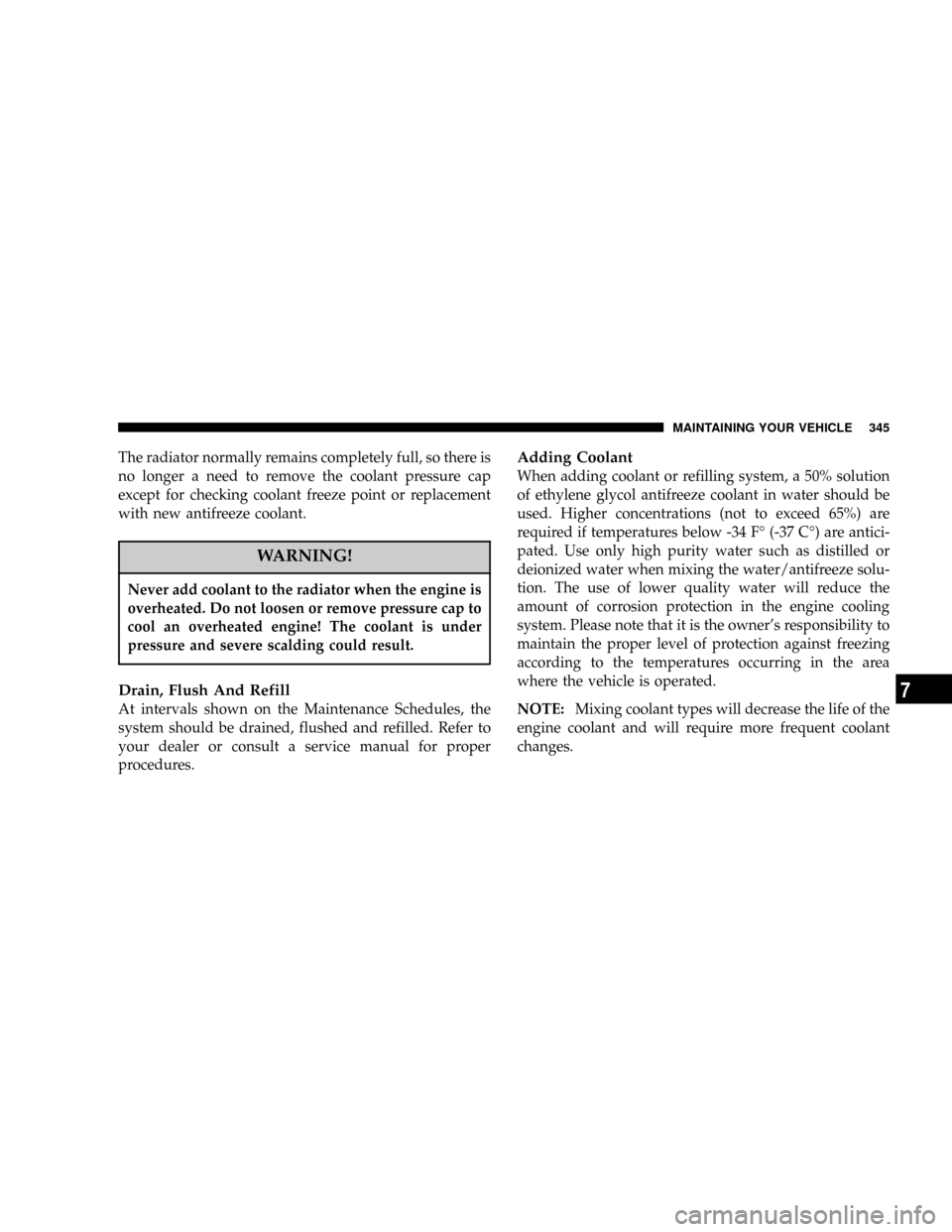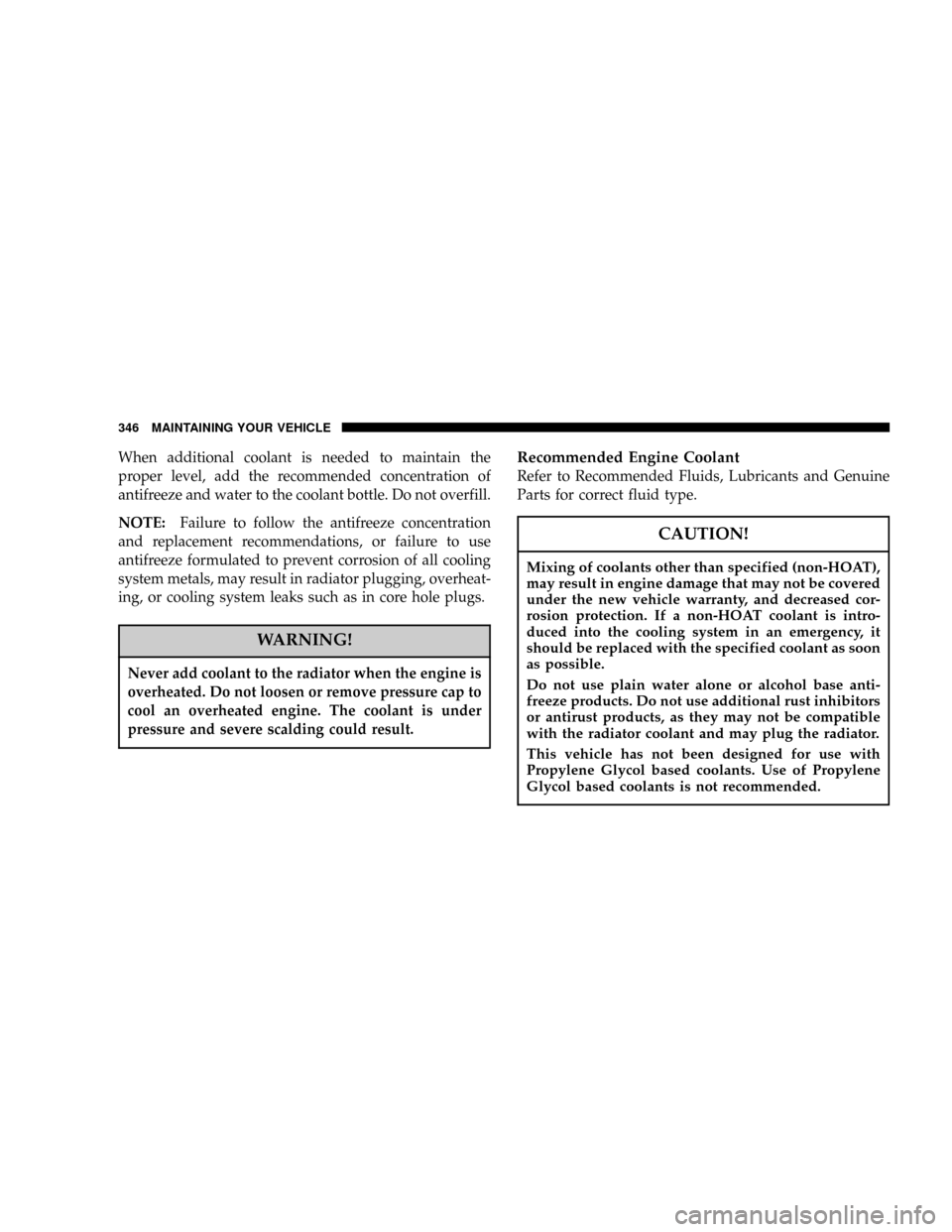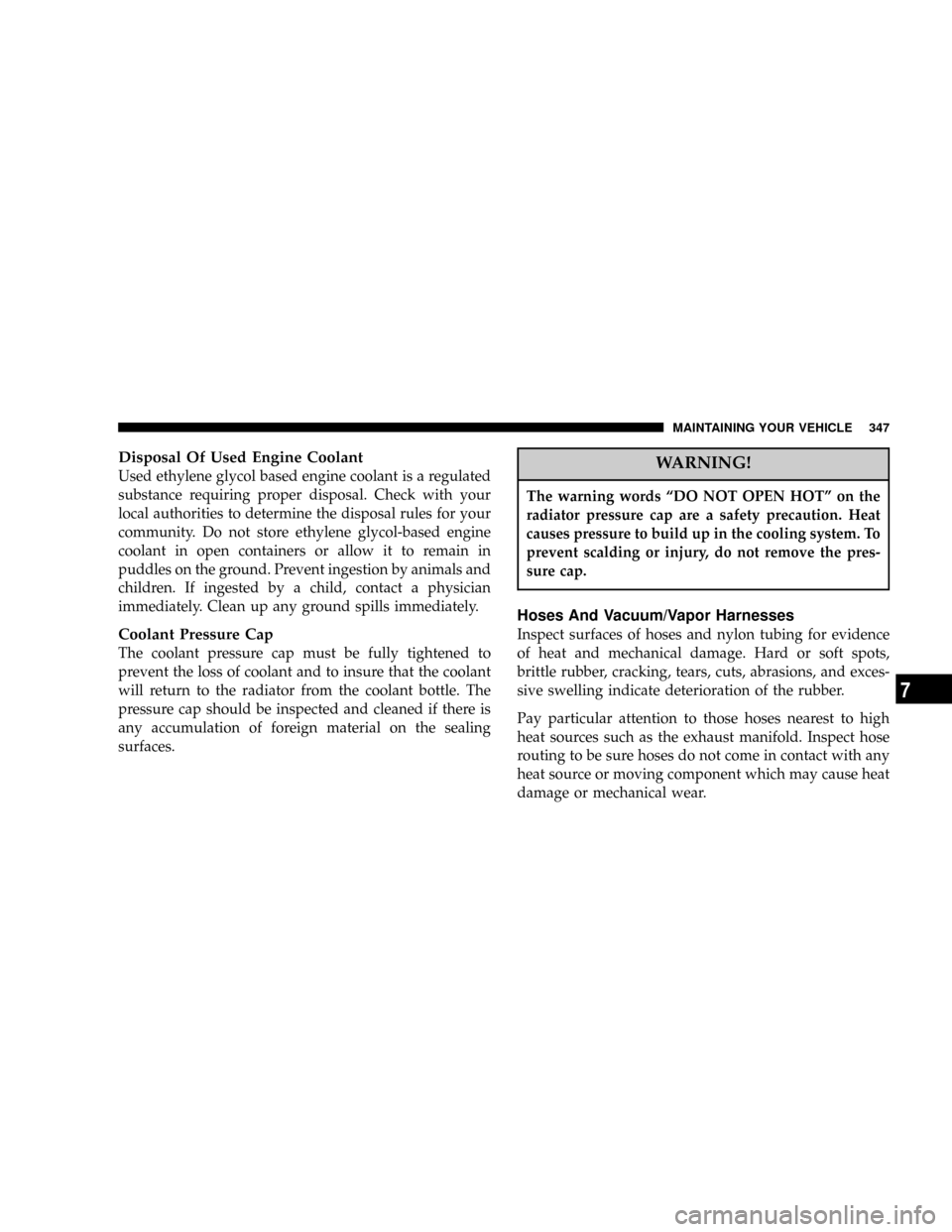Page 345 of 429

The radiator normally remains completely full, so there is
no longer a need to remove the coolant pressure cap
except for checking coolant freeze point or replacement
with new antifreeze coolant.
WARNING!
Never add coolant to the radiator when the engine is
overheated. Do not loosen or remove pressure cap to
cool an overheated engine! The coolant is under
pressure and severe scalding could result.
Drain, Flush And Refill
At intervals shown on the Maintenance Schedules, the
system should be drained, flushed and refilled. Refer to
your dealer or consult a service manual for proper
procedures.
Adding Coolant
When adding coolant or refilling system, a 50% solution
of ethylene glycol antifreeze coolant in water should be
used. Higher concentrations (not to exceed 65%) are
required if temperatures below -34 FÉ (-37 CÉ) are antici-
pated. Use only high purity water such as distilled or
deionized water when mixing the water/antifreeze solu-
tion. The use of lower quality water will reduce the
amount of corrosion protection in the engine cooling
system. Please note that it is the owner's responsibility to
maintain the proper level of protection against freezing
according to the temperatures occurring in the area
where the vehicle is operated.
NOTE:Mixing coolant types will decrease the life of the
engine coolant and will require more frequent coolant
changes.
MAINTAINING YOUR VEHICLE 345
7
Page 346 of 429

When additional coolant is needed to maintain the
proper level, add the recommended concentration of
antifreeze and water to the coolant bottle. Do not overfill.
NOTE:Failure to follow the antifreeze concentration
and replacement recommendations, or failure to use
antifreeze formulated to prevent corrosion of all cooling
system metals, may result in radiator plugging, overheat-
ing, or cooling system leaks such as in core hole plugs.
WARNING!
Never add coolant to the radiator when the engine is
overheated. Do not loosen or remove pressure cap to
cool an overheated engine. The coolant is under
pressure and severe scalding could result.
Recommended Engine Coolant
Refer to Recommended Fluids, Lubricants and Genuine
Parts for correct fluid type.
CAUTION!
Mixing of coolants other than specified (non-HOAT),
may result in engine damage that may not be covered
under the new vehicle warranty, and decreased cor-
rosion protection. If a non-HOAT coolant is intro-
duced into the cooling system in an emergency, it
should be replaced with the specified coolant as soon
as possible.
Do not use plain water alone or alcohol base anti-
freeze products. Do not use additional rust inhibitors
or antirust products, as they may not be compatible
with the radiator coolant and may plug the radiator.
This vehicle has not been designed for use with
Propylene Glycol based coolants. Use of Propylene
Glycol based coolants is not recommended.
346 MAINTAINING YOUR VEHICLE
Page 347 of 429

Disposal Of Used Engine Coolant
Used ethylene glycol based engine coolant is a regulated
substance requiring proper disposal. Check with your
local authorities to determine the disposal rules for your
community. Do not store ethylene glycol-based engine
coolant in open containers or allow it to remain in
puddles on the ground. Prevent ingestion by animals and
children. If ingested by a child, contact a physician
immediately. Clean up any ground spills immediately.
Coolant Pressure Cap
The coolant pressure cap must be fully tightened to
prevent the loss of coolant and to insure that the coolant
will return to the radiator from the coolant bottle. The
pressure cap should be inspected and cleaned if there is
any accumulation of foreign material on the sealing
surfaces.
WARNING!
The warning words ªDO NOT OPEN HOTº on the
radiator pressure cap are a safety precaution. Heat
causes pressure to build up in the cooling system. To
prevent scalding or injury, do not remove the pres-
sure cap.
Hoses And Vacuum/Vapor Harnesses
Inspect surfaces of hoses and nylon tubing for evidence
of heat and mechanical damage. Hard or soft spots,
brittle rubber, cracking, tears, cuts, abrasions, and exces-
sive swelling indicate deterioration of the rubber.
Pay particular attention to those hoses nearest to high
heat sources such as the exhaust manifold. Inspect hose
routing to be sure hoses do not come in contact with any
heat source or moving component which may cause heat
damage or mechanical wear.
MAINTAINING YOUR VEHICLE 347
7
Page 358 of 429

control prior to its sale or delivery to the ultimate
purchaser or while it is in use, or (2) the use of the vehicle
after such device or element of design has been removed
or rendered inoperative by any person.
Among those acts presumed to constitute tampering are
the acts listed below.
AIR CLEANER
²Removal of the air cleaner.
²Inverting the air cleaner lid.
²Removal of the air ducting.
EXHAUST SYSTEM
²Removal or rendering inoperative exhaust system
components including the muffler or tailpipe.ENGINE COOLING SYSTEM
²Removal or rendering inoperative the fan clutch.
²Removal of the fan shroud.
Noise Emission Warranty
The manufacturer warrants that this vehicle as manufac-
tured by the manufacturer, was designed, built and
equipped to conform at the time it left the manufacturers
control with all applicable U.S. EPA Noise Control Regu-
lations.
This warranty covers this vehicle as designed, built and
equipped by the manufacturer, and is not limited to any
particular part, component or system of the vehicle
manufactured by the manufacturer. Defects in design,
assembly or in any part, component or system of the
vehicle as manufactured by the manufacturer, which, at
the time it left the manufacturers control, caused noise
emissions to exceed Federal standards, are covered by
this warranty for the life of the vehicle.
358 MAINTAINING YOUR VEHICLE
Page 380 of 429
U.S. Metric
Cooling System
3.7L (MopartAntifreeze/Coolant 5 Year/100,000 Mile
Formula)17 qts. 16L
4.7L (MopartAntifreeze/Coolant 5 Year/100,000 Mile
Formula)17 qts. 16L
5.7L (MopartAntifreeze/Coolant 5 Year/100,000 Mile
Formula)18.7 qts. 17.7L
380 MAINTAINING YOUR VEHICLE
Page 416 of 429

Climate Control......................... 185
Clock................................ 151
Clutch............................... 349
Clutch Linkage Maintenance................ 350
Compact Disc Maintenance................. 184
Compact Disc Player..................158,164
Compact Spare Tire...................... 247
Compass.............................. 117
Compass Calibration..................... 117
Compass Variance....................... 118
Computer, Trip/Travel.................... 114
Console, Overhead....................... 113
Contract, Service........................ 406
Converter, Catalytic...................... 266
Cooling System......................... 344
Coolant Capacity...................... 379
Coolant Level......................... 344
Disposal of Used Coolant................ 347
Drain, Flush, and Refill.................. 345Inspection........................... 344
Radiator Cap......................344,347
Selection of Coolant...............346,379,381
Temperature Gauge..................... 146
Cruise Control.......................... 109
Cup Holder............................ 128
Customer Assistance..................... 404
Daytime Running Lights................... 102
Dealer Service.......................... 326
Defroster, Rear Window..............78,191,195
Defroster, Windshield..................186,189
Delay Wipers........................... 105
Differential, Limited-Slip.................. 228
Dipsticks
Automatic Transmission................. 352
Power Steering........................ 339
Disc Brakes............................ 348
416 INDEX